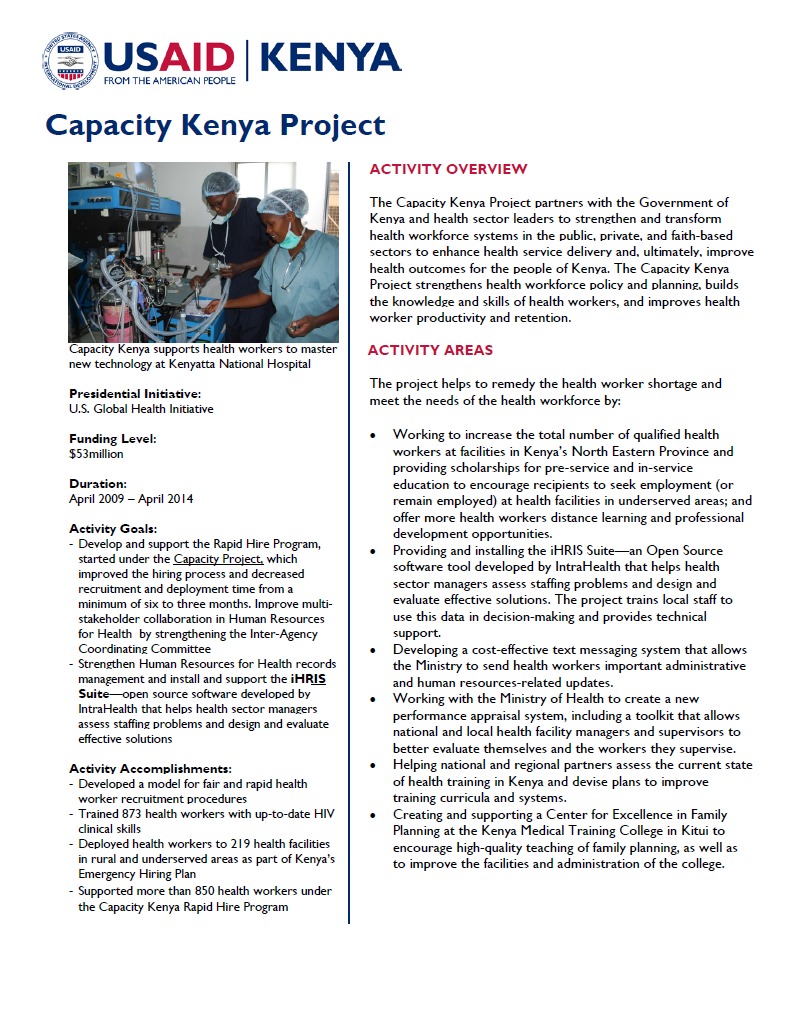|
Capacity Kenya Fact Sheet_February 2014 |
Presidential Initiative:
U.S. Global Health Initiative
Funding Level:
$53 million
Duration:
April 2009 – April 2014
Activity Goals:
- Develop and support the Rapid Hire Program, started under the Capacity Project, which improved the hiring process and decreased recruitment and deployment time from a minimum of six to three months. Improve multi-stakeholder collaboration in Human Resources for Health by strengthening the Inter-Agency Coordinating Committee
- Strengthen Human Resources for Health records management and install and support the iHRIS Suite—open source software developed by IntraHealth that helps health sector managers assess staffing problems and design and evaluate effective solutions
Activity Accomplishments:
- Developed a model for fair and rapid health worker recruitment procedures
- Trained 873 health workers with up-to-date HIV clinical skills
- Deployed health workers to 219 health facilities in rural and underserved areas as part of Kenya’s Emergency Hiring Plan
- Supported more than 850 health workers under the Capacity Kenya Rapid Hire Program
- Transitioned 125 health workers to Government of Kenya payroll this year bringing the total transitioned health workers to about 1000, or 53% of health workers hired by the project
Activity Locations:
Nationwide
Key Partners:
Ministry of Health, National AIDS and STI Control Programme, Kenya Medical Supplies Agency, Directorate of Human Resources Planning and Management
ACTIVITY OVERVIEW
The Capacity Kenya Project partners with the Government of Kenya and health sector leaders to strengthen and transform health workforce systems in the public, private, and faith-based sectors to enhance health service delivery and, ultimately, improve health outcomes for the people of Kenya. The Capacity Kenya Project strengthens health workforce policy and planning, builds the knowledge and skills of health workers, and improves health worker productivity and retention.
ACTIVITY AREAS
The project helps to remedy the health worker shortage and meet the needs of the health workforce by:
- Working to increase the total number of qualified health workers at facilities in Kenya’s North Eastern Province and providing scholarships for pre-service and in-service education to encourage recipients to seek employment (or remain employed) at health facilities in underserved areas; and offer more health workers distance learning and professional development opportunities.
- Providing and installing the iHRIS Suite—an Open Source software tool developed by IntraHealth that helps health sector managers assess staffing problems and design and evaluate effective solutions. The project trains local staff to use this data in decision-making and provides technical support.
- Developing a cost-effective text messaging system that allows the Ministry to send health workers important administrative and human resources-related updates.
- Working with the Ministry of Health to create a new performance appraisal system, including a toolkit that allows national and local health facility managers and supervisors to better evaluate themselves and the workers they supervise.
- Helping national and regional partners assess the current state of health training in Kenya and devise plans to improve training curricula and systems.
- Creating and supporting a Center for Excellence in Family Planning at the Kenya Medical Training College in Kitui to encourage high-quality teaching of family planning, as well as to improve the facilities and administration of the college.
ACTIVITY IMPACT
The Capacity Kenya Project is working to increase the total number of qualified health workers in Kenyan facilities that need them most.
USAID Contact:
Peter Waithaka, Activity Manager
Office of Population and Health
USAID/Kenya
Tel: +254 20 862 2330
Email: pwaithaka@usaid.gov
Capacity Kenya Project Contact:
Meshack Ndolo, Chief of Party
Capacity Kenya
Tel: +20 254 374 6845/53
Email: mndolo@intrahealth.org
Website:
http://www.intrahealth.org/page/capacity-kenya
Updated February 2014








Comment
Make a general inquiry or suggest an improvement.